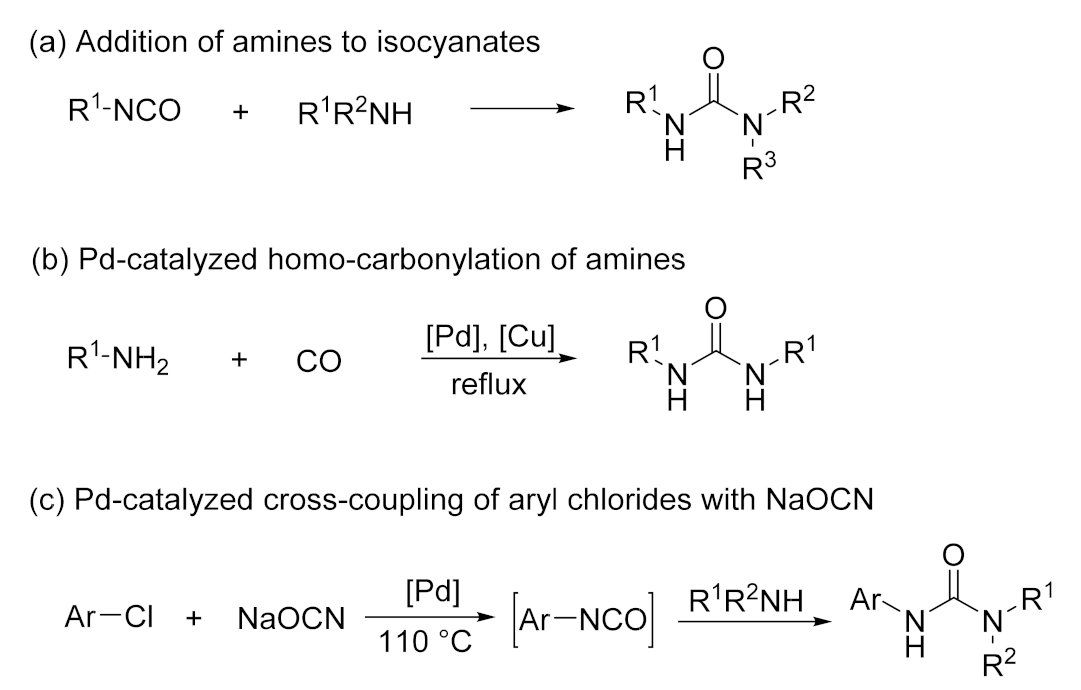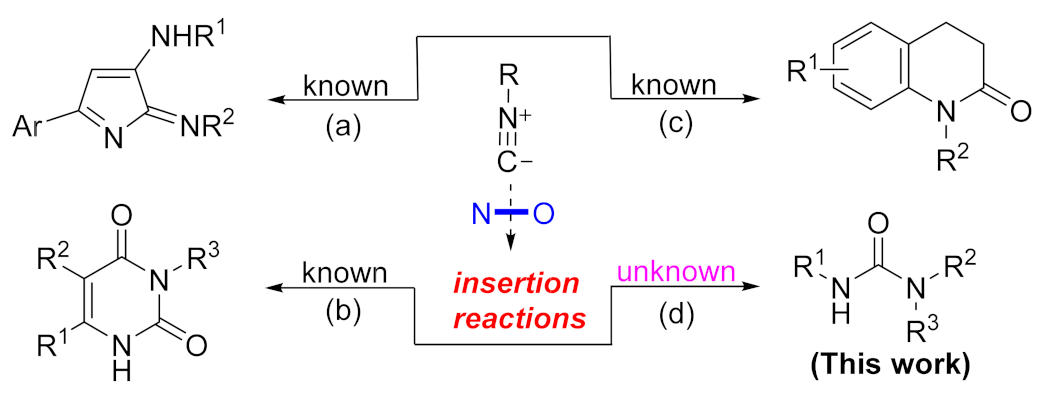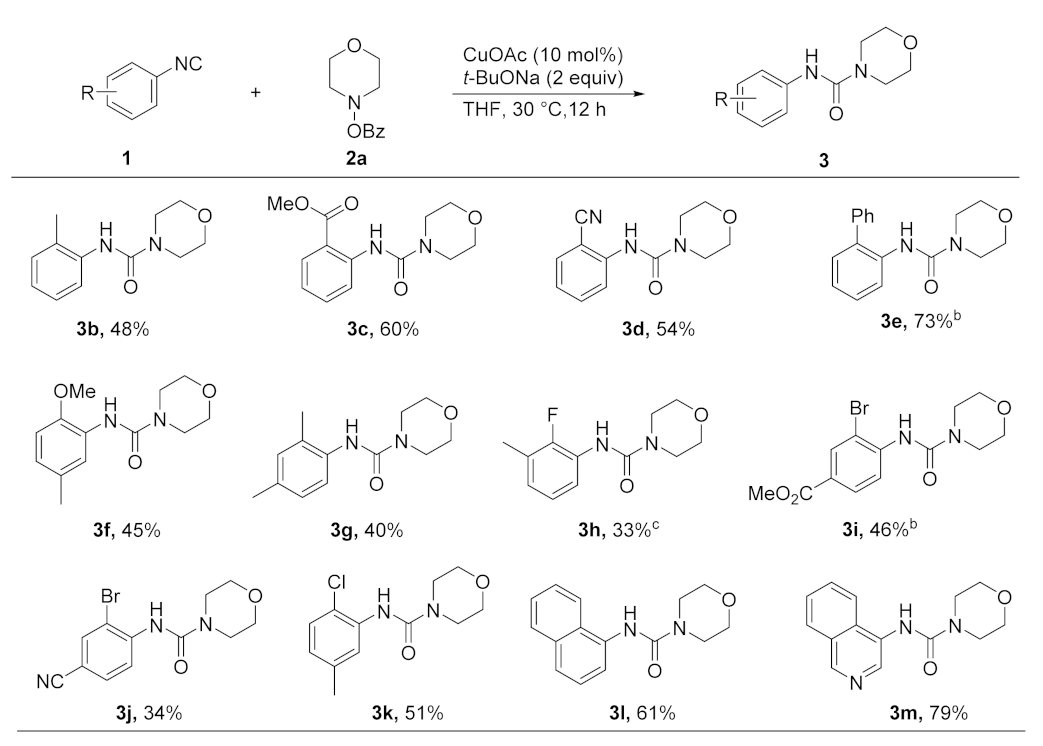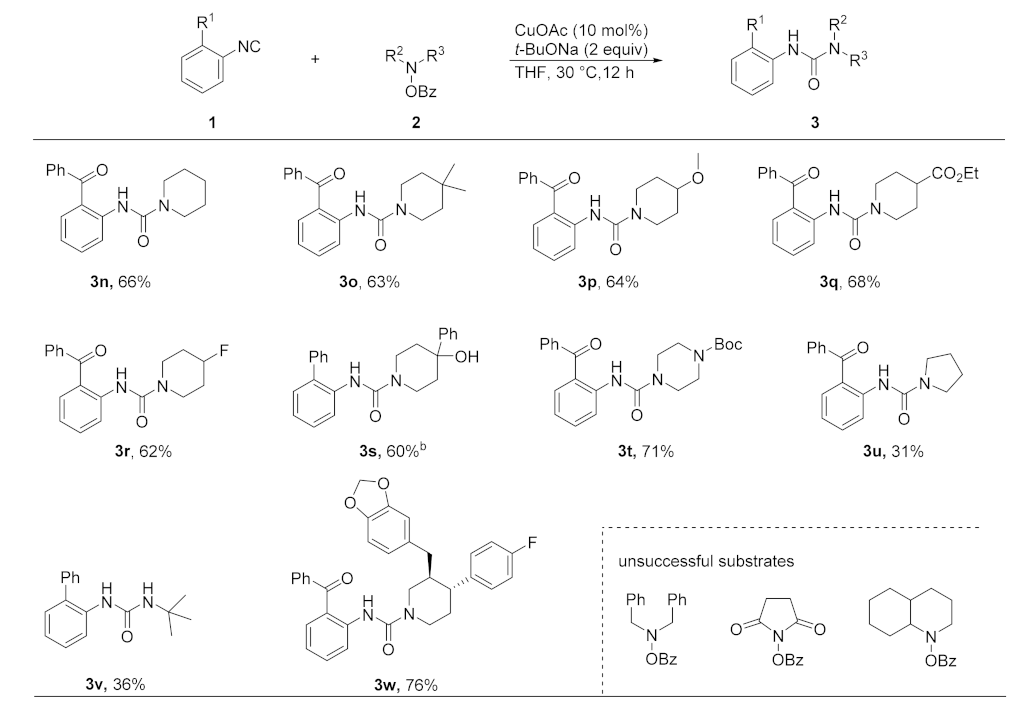Urea Synthesis from Isocyanides and O-Benzoyl Hydroxylamines Catalyzed by a Copper Salt
Abstract
1. Introduction
2. Results and Discussion
2.1. Optimization of Reaction Conditions
2.2. Substrate Scope
3. Materials and Methods
3.1. Preparation of Substrates
3.2. Preparation of Isocyanides (1)
- N-Formylation
- Dehydration
3.3. Preparation of O-Benzoyl Hydroxylamines (2)
3.4. General Procedures for Ureas
- N-(2-benzoylphenyl)morpholine-4-carboxamide (3a)
- N-(o-tolyl)morpholine-4-carboxamide (3b)
- Methyl 2-(morpholine-4-carboxamido)benzoate (3c)
- N-(2-cyanophenyl)morpholine-4-carboxamide (3d)
- N-([1,1′-biphenyl]-2-yl)morpholine-4-carboxamide (3e)
- N-(2-methoxy-5-methylphenyl)morpholine-4-carboxamide (3f)
- N-(2,4-dimethylphenyl)morpholine-4-carboxamide (3g)
- N-(2-fluoro-3-methylphenyl)morpholine-4-carboxamide (3h)
- Methyl 3-bromo-4-(piperidine-1-carboxamido)benzoate (3i)
- N-(2-bromo-4-cyanophenyl)morpholine-4-carboxamide (3j)
- N-(2-chloro-5-methylphenyl)morpholine-4-carboxamide (3k)
- N-(naphthalen-1-yl)morpholine-4-carboxamide (3l)
- N-(isoquinolin-4-yl)morpholine-4-carboxamide (3m)
- N-(2-benzoylphenyl)piperidine-1-carboxamide (3n)
- N-(2-benzoylphenyl)-4,4-dimethylpiperidine-1-carboxamide (3o)
- N-(2-benzoylphenyl)-4-methoxypiperidine-1-carboxamide (3p)
- Ethyl 1-((2-benzoylphenyl)carbamoyl)piperidine-4-carboxylate (3q)
- N-(2-benzoylphenyl)-4-fluoropiperidine-1-carboxamide (3r)
- N-([1,1′-biphenyl]-2-yl)-4-hydroxy-4-phenylpiperidine-1-carboxamide (3s)
- Tert-butyl 4-((2-benzoylphenyl)carbamoyl)piperazine-1-carboxylate (3t)
- N-(2-benzoylphenyl)pyrrolidine-1-carboxamide (3u)
- 1-([1,1′-biphenyl]-2-yl)-3-(tert-butyl)urea (3v)
4. Conclusions
Supplementary Materials
Author Contributions
Funding
Institutional Review Board Statement
Informed Consent Statement
Data Availability Statement
Acknowledgments
Conflicts of Interest
Sample Availability
References
- Cabrera, A.; Cox, L.; Velarde, P.; Koskinen, W.C.; Cornejo, J. Fate of Diuron and terbuthylazine in soils amended with two-phase olive oil mill waste. J. Agric. Food Chem. 2007, 55, 4828–4834. [Google Scholar] [CrossRef] [PubMed]
- Santella, J.B.; Gardner, D.S.; Duncia, J.V.; Wu, H.; Dhar, M.; Cavallaro, C.; Tebben, A.J.; Carter, P.H.; Barrish, J.C.; Yarde, M.; et al. Discovery of the CCR1 antagonist, BMS-817399, for the treatment of rheumatoid arthritis. J. Med. Chem. 2014, 57, 7550–7564. [Google Scholar] [CrossRef] [PubMed]
- Matzen, L.; van Amsterdam, C.; Rautenberg, W.; Greiner, H.E.; Harting, J.; Seyfried, C.A.; Böttcher, H. 5-HT reuptake inhibitors with 5-HT1B/1D antagonistic activity: A new approach toward efficient antidepressants. J. Med. Chem. 2000, 43, 1149–1157. [Google Scholar] [CrossRef] [PubMed]
- Wu, J.; Xie, Y.; Chen, X.; Deng, G.-J. Transition metal-free carbazole synthesis from arylureas and cyclohexanones. Adv. Synth. Catal. 2016, 358, 3206–3211. [Google Scholar] [CrossRef]
- Fan, W.; Queneau, Y.; Popowycz, F. HMF in multicomponent reactions: Utilization of 5-hydroxymethylfurfural (HMF) in the Biginelli reaction. Green Chem. 2018, 20, 485–492. [Google Scholar] [CrossRef]
- Doyle, A.G.; Jacobsen, E.J. Small-molecule H-bond donors in asymmetric catalysis. Chem. Rev. 2007, 107, 5713–5743. [Google Scholar] [CrossRef]
- Yang, T.; Ferrali, A.; Sladojevich, F.; Campbell, L.; Dixon, D.J. Brønsted base/Lewis acid cooperative catalysis in the enantioselective Conia-Ene reaction. J. Am. Chem. Soc. 2009, 131, 9140–9141. [Google Scholar] [CrossRef]
- Bigi, F.; Maggi, R.; Sartori, G. Selected syntheses of ureas through phosgene substitutes. Green Chem. 2000, 2, 140–148. [Google Scholar] [CrossRef]
- Padiya, K.J.; Gavade, S.; Kardile, B.; Tiwari, M.; Bajare, S.; Mane, M.; Gaware, V.; Varghese, S.; Harel, D.; Kurhade, S. Unprecedented “in water” imidazole carbonylation: Paradigm shift for preparation of urea and carbamate. Org. Lett. 2012, 14, 2814–2817. [Google Scholar] [CrossRef]
- Guan, Z.-H.; Lei, H.; Chen, M.; Ren, Z.-H.; Bai, Y.; Wang, Y.-Y. Palladium-catalyzed carbonylation of amines: Switchable approaches to carbamates and N,N′-disubstituted Ureas. Adv. Synth. Catal. 2012, 354, 488–496. [Google Scholar] [CrossRef]
- Vinogradova, E.V.; Fors, B.P.; Buchwald, S.L. Palladium-catalyzed cross-coupling of aryl chlorides and triflates with sodium cyanate: A practical synthesis of unsymmetrical ureas. J. Am. Chem. Soc. 2012, 134, 11132–11135. [Google Scholar] [CrossRef]
- Giustiniano, M.; Basso, A.; Mercalli, V.; Massarotti, A.; Novellino, E.; Tron, G.C.; Zhu, J. To ech his own: Isonitriles for all flavors. Functionalized isocyanides as valuable tools in organic synthesis. Chem. Soc. Rev. 2017, 46, 1295–1357. [Google Scholar] [CrossRef] [PubMed]
- Dömling, A.; Ugi, I. Multicomponent reactions with isocyanides. Angew. Chem. Int. Ed. 2000, 39, 3168–3210. [Google Scholar] [CrossRef]
- Liu, J.; Fang, Z.; Zhang, Q.; Liu, Q.; Bi, X. Silver-catalyzed isocyanide-alkyne cycloaddition: A general and practical method to oligosubstituted pyrroles. Angew. Chem. Int. Ed. 2013, 52, 6953–6957. [Google Scholar] [CrossRef]
- Gao, M.; He, C.; Chen, H.; Bai, R.; Cheng, B.; Lei, A. Synthesis of pyrroles by click reaction: Silver-catalyzed cycloaddition of terminal alkynes with isocyanides. Angew. Chem. Int. Ed. 2013, 52, 6958–6961. [Google Scholar] [CrossRef]
- Qiu, G.; Ding, Q.; Wu, J. Recent advances in isocyanide insertion chemistry. Chem. Soc. Rev. 2013, 42, 5257–5269. [Google Scholar] [CrossRef] [PubMed]
- Hu, W.; Li, J.; Xu, Y.; Li, J.; Wu, W.; Liu, H.; Jiang, H. Palladium-catalyzed redox-neutral N–O/C(sp3)–H functionalization of aryl oximes with isocyanides. Org. Lett. 2017, 19, 678–681. [Google Scholar] [CrossRef]
- Senadi, G.C.; Lu, T.-Y.; Dhandabani, G.K.; Wang, J.-J. Palladium-catalyzed double-isocyanide insertion via oxidative N–O cleavage of acetyl oximes: Syntheses of 2H-pyrrol-2-imines. Org. Lett. 2017, 19, 1172–1175. [Google Scholar] [CrossRef]
- Liang, H.-W.; Yang, Z.; Jiang, K.; Ye, Y.; Wei, Y. Atom-economic silver-catalyzed difunctionalization of the isocyano group with cyclic oximes: Towards pyrimidinediones. Angew. Chem. Int. Ed. 2018, 57, 5720–5724. [Google Scholar] [CrossRef] [PubMed]
- Yang, Z.; Jiang, K.; Chen, Y.-C.; Wei, Y. Copper-catalyzed dihydroquinolinone synthesis from isocyanides and O-benzoyl hydroxylamines. J. Org. Chem. 2019, 84, 3725–3734. [Google Scholar] [CrossRef]
- Liang, W.; Jiang, K.; Du, F.; Yang, J.; Shuai, L.; Ouyang, Q.; Chen, Y.-C.; Wei, Y. Iron-catalyzed, iminyl radical-triggered cascade 1,5-hydrogen atom transfer/(5 + 2) or (5 + 1) annulation: Oxime as a five-atom assembling unit. Angew. Chem. Int. Ed. 2020, 59, 19222–19228. [Google Scholar] [CrossRef] [PubMed]
- Du, F.; Li, S.-J.; Jiang, K.; Zeng, R.; Pan, X.-C.; Lan, Y.; Chen, Y.-C.; Wei, Y. Iron-catalyzed radical relay enabling the modular synthesis of fused pyridines from alkyne-tethered oximes and alkenes. Angew. Chem. Int. Ed. 2020, 59, 23755–23762. [Google Scholar] [CrossRef]
- Jiang, K.; Li, S.-J.; Liu, Q.-P.; Yu, N.; Li, Y.-L.; Zhou, Y.-Q.; He, K.-C.; Lin, J.; Zheng, T.-Y.; Lang, J.; et al. Iminyl radical-triggered relay annulation for the construction of bridged aza-tetracycles bearing four contiguous stereogenic centers. Chem. Sci. 2022, 13, 7283–7288. [Google Scholar] [CrossRef] [PubMed]
- Berman, A.M.; Johnson, J.S. Copper-catalyzed electrophilic amination of diorganozinc reagents. J. Am. Chem. Soc. 2004, 126, 5680–5681. [Google Scholar] [CrossRef] [PubMed]
- Barker, T.J.; Jarvo, E.R. Developments in transition-metal-catalyzed reactions using electrophilic nitrogen sources. Synthesis 2011, 2011, 3954–3964. [Google Scholar]
- Matsuda, N.; Hirano, K.; Satoh, T.; Miura, M. Copper-catalyzed amination of arylboronates with N,N-dialkylhydroxylamines. Angew. Chem. Int. Ed. 2012, 51, 3642–3645. [Google Scholar] [CrossRef]
- Rucker, R.P.; Whittaker, A.M.; Dang, H.; Lalic, G. Synthesis of hindered anilines: Copper-catalyzed electrophilic amination of aryl boronic esters. Angew. Chem. Int. Ed. 2012, 51, 3953–3956. [Google Scholar] [CrossRef]
- Shi, S.-L.; Buchwald, S.L. Copper-catalysed selective hydroamination reactions of alkynes. Nat. Chem. 2015, 7, 38–44. [Google Scholar] [CrossRef]
- Schwarz, J.S.P. Preparation of acyclic isoimides and their rearrangement rates to imides. J. Org. Chem. 1972, 37, 2906–2908. [Google Scholar] [CrossRef]






 | ||||
|---|---|---|---|---|
| Entry | Catalyst | Base | Solvent | Yield (%) b |
| 1 | CuOAc | NaOAc | THF | 0 |
| 2 | CuOAc | K2CO3 | THF | 0 |
| 3 | CuOAc | NaHCO3 | THF | 0 |
| 4 | CuOAc | PhCO2Na | THF | 0 |
| 5 | CuOAc | PivONa | THF | 0 |
| 6 | CuOAc | PhONa | THF | 23 |
| 7 | CuOAc | t-BuONa | THF | 86 |
| 8 | CuI | t-BuONa | THF | 74 |
| 9 | CuBr2 | t-BuONa | THF | 65 |
| 10 | FeCl2 | t-BuONa | THF | trace |
| 11 | - | t-BuONa | THF | 0 |
| 12 | CuOAc | t-BuONa | DMSO | messy |
| 13 | CuOAc | t-BuONa | MeCN | <5 |
Publisher’s Note: MDPI stays neutral with regard to jurisdictional claims in published maps and institutional affiliations. |
© 2022 by the authors. Licensee MDPI, Basel, Switzerland. This article is an open access article distributed under the terms and conditions of the Creative Commons Attribution (CC BY) license (https://creativecommons.org/licenses/by/4.0/).
Share and Cite
Yu, N.; Lv, J.-F.; He, S.-M.; Cui, Y.; Wei, Y.; Jiang, K. Urea Synthesis from Isocyanides and O-Benzoyl Hydroxylamines Catalyzed by a Copper Salt. Molecules 2022, 27, 8219. https://doi.org/10.3390/molecules27238219
Yu N, Lv J-F, He S-M, Cui Y, Wei Y, Jiang K. Urea Synthesis from Isocyanides and O-Benzoyl Hydroxylamines Catalyzed by a Copper Salt. Molecules. 2022; 27(23):8219. https://doi.org/10.3390/molecules27238219
Chicago/Turabian StyleYu, Ning, Jing-Fang Lv, Shi-Mei He, Yanyan Cui, Ye Wei, and Kun Jiang. 2022. "Urea Synthesis from Isocyanides and O-Benzoyl Hydroxylamines Catalyzed by a Copper Salt" Molecules 27, no. 23: 8219. https://doi.org/10.3390/molecules27238219
APA StyleYu, N., Lv, J.-F., He, S.-M., Cui, Y., Wei, Y., & Jiang, K. (2022). Urea Synthesis from Isocyanides and O-Benzoyl Hydroxylamines Catalyzed by a Copper Salt. Molecules, 27(23), 8219. https://doi.org/10.3390/molecules27238219





